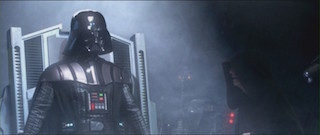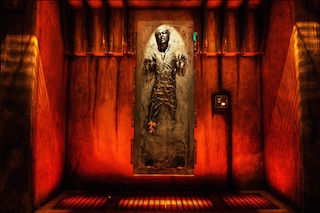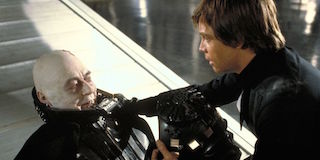Before the “Noooo” heard round-the-world, the goosebumps rise when Ian McDiarmid menacingly beckons Darth Vader, invoking some Frankenstein-ian parallels, from the table of his recreation in the final scenes of Revenge of the Sith. Before his near-death battle with Obi-Wan Kenobi, The Emperor utters, “Rise”, after christening Anakin Skywalker, Lord Vader. The theme of death and resurrection, or as George Lucas calls it in his commentary on Return of the Jedi, “death and rebirth,” is given one last powerful refrain in the Star Wars movies. From the plunging of Luke into the bowels of Cloud City, Han’s cold, hard death in a block carbonite, and Vader’s subsequent re-resurrection, death and rebirth is a consistent and affecting theme within the story of Star Wars.
Vader’s rise from the charred, barely alive remains of Anakin Skywalker is a literal rebirth from the ashes and a spiritual anti-resurrection from the light to the darkness. Obi-Wan Kenobi’s “certain point of view” of Anakin’s death at the hands of Vader seems more truth than a white lie to protect Anakin’s force-sensitive offspring of Luke and Leia. Now machine more than man, Anakin’s goodness, the little bit Luke senses in him decades later, has been betrayed by the combined lust of Vader and the Emperor and destroyed. His anti-resurrection; from hero to villain, friend to enemy, husband to murderer, chosen one to betrayer; is now complete. In the scope of the prequels, it is a sad, ominous anti-climax. Read in tandem with the original trilogy, it strikes a hopeful harmony as the events of Empire Strikes Back and Return of the Jedi are a hopeful countermelody to Vader’s initial, chronological dark side turn.
Flash forward twenty-two years later, instead of the Emperor christening the allegiance of Anakin Skywalker, it is the elder Skywalker, now the Dark Lord of the Sith, beckoning his son to join the ranks of the dark side. As Luke stares down the inevitability of capture at the hands of Vader or to willingly join him, Luke makes the courageous and sacrificial decision to embrace death. He gives up his spirit of adventure and excitement and accepts his death by plunging into the abyss of Bespin’s tibanna gas mines. While he is saved from death by the return of his yet unknown sister, Luke has already been reborn. As the events of Empire close and the events of Jedi blossom, Luke has accepted the turn of events that he has confronted his father, failed, and shirked Vader’s temptations to fight for love, family, and the triumph of good. In a deleted scene from Jedi, Vader reaches out across the stars with the Force to Luke, now staging the rescue of Han on Tatooine, and again entices him to join him and it is the only way. Luke merely shrugs it off, ignites his newly completed green lightsaber, and heads out to reunite with his friends.
 Han, the rescue mission’s target, once he is rescued from the slimy haunches of Jabba the Hutt, has gone through his own death and rebirth. From the smuggling holds of the Millennium Falcon to shooting first and spending the night inside a tauntaun, Solo has been the master of cheating death. However, his number seems to be up with the arrival of both the notorious bounty hunter Boba Fett, and Vader himself. He is frozen in carbonite to test the device for Luke and willingly gives himself over the carbon freezing as long as Leia and Chewie are kept safe.
Han, the rescue mission’s target, once he is rescued from the slimy haunches of Jabba the Hutt, has gone through his own death and rebirth. From the smuggling holds of the Millennium Falcon to shooting first and spending the night inside a tauntaun, Solo has been the master of cheating death. However, his number seems to be up with the arrival of both the notorious bounty hunter Boba Fett, and Vader himself. He is frozen in carbonite to test the device for Luke and willingly gives himself over the carbon freezing as long as Leia and Chewie are kept safe.
Outside of the movie itself, Solo’s time seemed to be up with the inability of Lucas and 20th Century Fox to secure Harrison Ford for Return of the Jedi and Ford’s desire to no longer put on the smuggler’s vest. The freezing of Solo in carbonite at the end of Empire was not only a critical emotional beat within the movie but also an insurance policy against Ford exiting the role and effectively ending Solo’s life within the Star Wars universe.
However, once Ford was signed, his resurrection and rebirth as a different sort of rogue were set in stone. He is released from the carbon freeze and Jabba’s art collection by a disguised Princess Leia and after some more heroics from our rebel band, Solo is now a general, Rebel, and Leia’s born again beau. Gone is the once skeptical, distant criminal looking to score a big payday ferrying an old man and a sandy-haired farm boy to Alderaan. He has been resurrected as a freedom fighter, friend, and flame.
While the reborn Solo toils as a general on the forest moon of Endor, Luke willingly gives himself up to confront his father. However, this time, it is not as a Jedi or warrior, but as a son. When they finally meet, Luke pleads with his father to fight the evil inside him and he still senses the good in him. Vader remarks, “it is too late for me, son,” and takes him to the Emperor. Seemingly, Vader has withstood the love of his son and has passed his own test to remain true to his life as a Sith.
However, Luke’s transformation will become the catalyst for Vader’s own death and rebirth. Only moments from destroying his father, Luke recants and embraces the Jedi way. He throws down his lightsaber, invokes the powerful memory of his father, Anakin, and refuses to join the Emperor or kill his father. The Emperor, the only truly twisted and evil one in the Star Wars universe, sets on Luke to destroy him. Moved by his son’s compassion for him and the Emperor’s callous disregard for both Skywalker’s lives, he turns on his master and hurls him into the core of the Death Star. In that moment, Anakin Skywalker has been reborn and the old Vader has passed away. It’s not too late for him. As one untimely born, the true Chosen One, Anakin’s son, has brought balance to the Force and, in love, raised his father from the dead.
 The story of Star Wars comes around in a beautiful full circle. The virtue of sacrificing oneself for the sake of others begets resurrection, a new life, and a new hope. This may be the most Christian thread that runs throughout the six Star Wars movies. Anakin embodies the fallen man, created to bring balance but betraying those who loved him and murdering the very people he loved. But out of his tragedy, a new hope emerges in the form of his son. He lovingly gives up his own life to rescue others’ lives and is subsequently resurrected as a true, sacrificial hero. He then returns to his father, the fallen man, and through the power of love he defeats evil, which is cast into a pit, and triumphs in restoring what was once fallen and broken. Vader’s last lines of, “you were right,” is proof positive of Luke’s journey being complete. Balance is restored, evil is defeated, and death has lost its sting for his once fallen father.
The story of Star Wars comes around in a beautiful full circle. The virtue of sacrificing oneself for the sake of others begets resurrection, a new life, and a new hope. This may be the most Christian thread that runs throughout the six Star Wars movies. Anakin embodies the fallen man, created to bring balance but betraying those who loved him and murdering the very people he loved. But out of his tragedy, a new hope emerges in the form of his son. He lovingly gives up his own life to rescue others’ lives and is subsequently resurrected as a true, sacrificial hero. He then returns to his father, the fallen man, and through the power of love he defeats evil, which is cast into a pit, and triumphs in restoring what was once fallen and broken. Vader’s last lines of, “you were right,” is proof positive of Luke’s journey being complete. Balance is restored, evil is defeated, and death has lost its sting for his once fallen father.
While the resurrection of the Star Wars franchise means that what was once made whole may have been broken again, it is a brand new hope for a brand new generation. Let’s hope these same themes continue anew in today’s world, where Star Wars movies will never end.
